广州版小学英语知识点总结
广州版小学知识点全
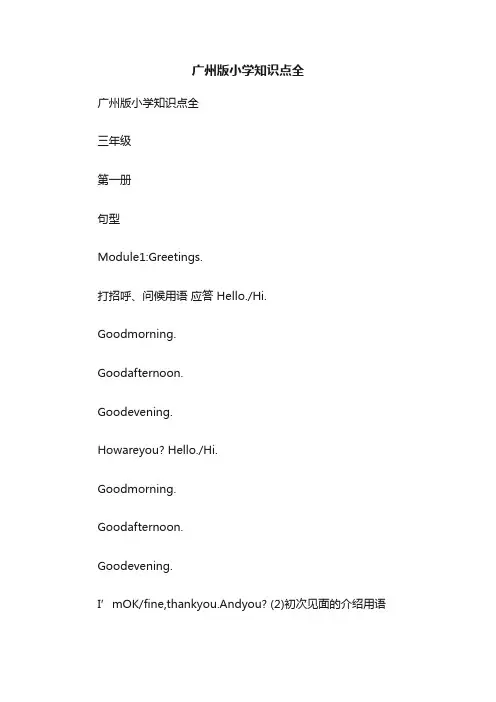
广州版小学知识点全广州版小学知识点全三年级第一册句型Module1:Greetings.打招呼、问候用语应答 Hello./Hi.Goodmorning.Goodafternoon.Goodevening.Howareyou? Hello./Hi.Goodmorning.Goodafternoon.Goodevening.I’mOK/fine,thankyou.Andyou? (2)初次见面的介绍用语初次见面的介绍用语应答Mynameis…/I’m…Thisis…Nicetomeetyou.Nicetomeetyou,too. 二、语法1.把肯定句改成否定句、一般疑问句。
2.对下面的句型作出肯定或否定的回答。
3.Mr(先生),Miss(小姐),Mrs(太太)后面跟姓,不能只跟名4.名词的单复数(1)英语的名词有单复数之分,单数是指“一”,复数指“二或二以上”。
名词的单数变复数,通常在名词后加-s.(2)注意区别I(我)与my(我的),you(你)与your(你的)。
(3)句子开头第一个字母要大写。
(4)称呼爸爸、妈妈要大写。
Allright,Dad.OK,Mum.(5)姓名第一个字母要大写。
(6)英国人的姓氏放在名字的后面。
5.语法。
Where''s=whereis,isn''t=isnot,here''s=hereis,that''s=thatis6.on在……上面in在……里面7.把肯定句改成否定句,只要在是动词be(am/is/are)之后加not,或者把are/is改写成aren''t/isn''t构成否定式。
把肯定句改成一般疑问句只要把是动词be(am/is/are)移到句首,以动词be开头,并且把句末标点符号改为“?”.8.特殊疑问句Whereis…?问的是物体在那里,应使用方位介词(on/in/under…)等回答第二册一、句型Isthis/that/it….?Yes,itis./No,itisn''t.Ishe/she….?Yes,he/sheis.No,he/sheisn''t.Isthere…..?Yes,thereis.No,thereisn''t.Arethese/those/they?Yes,theyare.Notheyaren''t.Arethere?.?Yes,thereare.No,therearen''t.Areyou?Yes,Iam./No,I抦not.Doyou?.?Yes,Ido./No,Idon抰.Whoishe/she?He/Sheis?Whoarethey?They抮e?Whatarethese/those/they?They抮e?.What抯yourname?I抦..Whatisthis/that/it?It抯厖Whatcoloris??It抯?Whatcolorare---?They抮---Whereareyoufrom?I抦from?.Whereishe/shefrom?He/Sheisfrom?. Wherearetheyfrom?They抮efrom?Whereis??It抯in/on/under?.Whereare?.?They抮ein/on/under….. Howmany…arethere?单数:Thereisone.复数:Thereare….二、语法1)可数名词变复数的规则一般情况,直接在名词后面加“s”.以“s,x,sh,ch”结尾,在后面加“es”.以辅音字母+y结尾的名词,改y变i再加es.不规则:①复数不变:sheep—sheep②不规则:goose—geese◆不可数名词(不加s)2)“是”动词有三个:amareis第一人称单数:I—am第二人称单数:you—are第三人称单数:he,she,it—is全部复数都用:are注意不可数名词:Isthereanytissueonthetable?3)some和anysome和any的主要区别为:some和any都表示“一些”,但是“some”用于肯定句,any用于否定句(not;n’t)和疑问句(?)。
广州版小学英语知识点总结
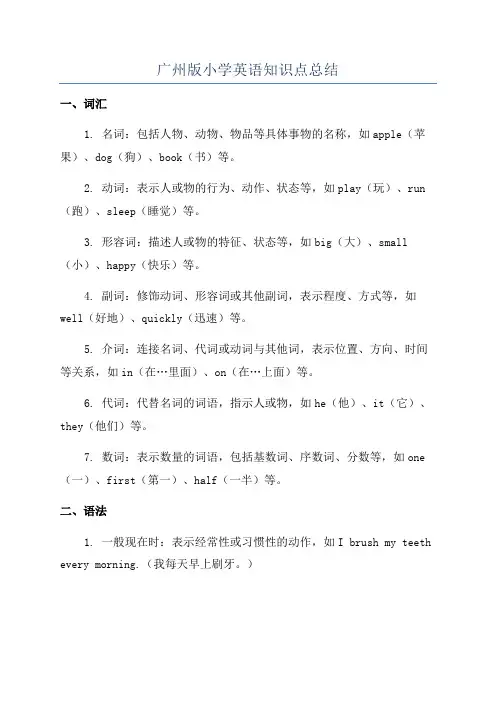
广州版小学英语知识点总结一、词汇1. 名词:包括人物、动物、物品等具体事物的名称,如apple(苹果)、dog(狗)、book(书)等。
2. 动词:表示人或物的行为、动作、状态等,如play(玩)、run (跑)、sleep(睡觉)等。
3. 形容词:描述人或物的特征、状态等,如big(大)、small (小)、happy(快乐)等。
4. 副词:修饰动词、形容词或其他副词,表示程度、方式等,如well(好地)、quickly(迅速)等。
5. 介词:连接名词、代词或动词与其他词,表示位置、方向、时间等关系,如in(在…里面)、on(在…上面)等。
6. 代词:代替名词的词语,指示人或物,如he(他)、it(它)、they(他们)等。
7. 数词:表示数量的词语,包括基数词、序数词、分数等,如one (一)、first(第一)、half(一半)等。
二、语法1. 一般现在时:表示经常性或习惯性的动作,如I brush my teeth every morning.(我每天早上刷牙。
)2. 疑问句和否定句:在句子中加入疑问词或助动词构成疑问句,如Does she have a pet?(她有宠物吗?)为动词加not构成否定句,如I do not like vegetables.(我不喜欢蔬菜。
)3. 一般过去时:表示过去发生的动作或存在的状态,如He played football yesterday.(他昨天踢足球。
)4. 有...的人或物:用“have/has”表达人或物具有其中一种特征或拥有其中一种东西,如I have a cat.(我有一只猫。
)5. 情态动词can:表示能力、许可或可能性,如He can swim.(他会游泳。
)6. 以...做为:用介词“as”表示对象具有其中一种特征或扮演其中一种角色,如He works as a doctor.(他以医生为职业。
)7. 形容词的比较级和最高级:用于比较两个或多个事物的大小、高低等,如She is taller than me.(她比我高。
小学(广州版)英语语法大全
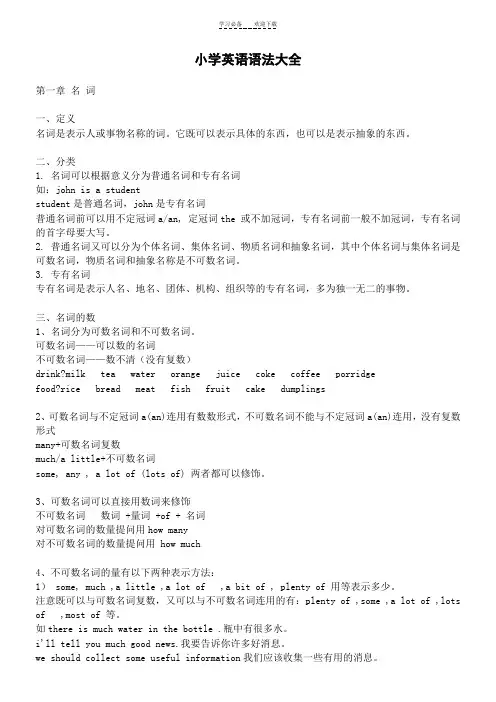
小学英语语法大全第一章名词一、定义名词是表示人或事物名称的词。
它既可以表示具体的东西,也可以是表示抽象的东西。
二、分类1. 名词可以根据意义分为普通名词和专有名词如:john is a studentstudent是普通名词,john是专有名词普通名词前可以用不定冠词a/an, 定冠词the 或不加冠词,专有名词前一般不加冠词,专有名词的首字母要大写。
2. 普通名词又可以分为个体名词、集体名词、物质名词和抽象名词,其中个体名词与集体名词是可数名词,物质名词和抽象名称是不可数名词。
3. 专有名词专有名词是表示人名、地名、团体、机构、组织等的专有名词,多为独一无二的事物。
三、名词的数1、名词分为可数名词和不可数名词。
可数名词——可以数的名词不可数名词——数不清(没有复数)drink?milk tea water orange juice coke coffee porridgefood?rice bread meat fish fruit cake dumplings2、可数名词与不定冠词a(an)连用有数数形式,不可数名词不能与不定冠词a(an)连用,没有复数形式many+可数名词复数much/a little+不可数名词some, any , a lot of (lots of) 两者都可以修饰。
3、可数名词可以直接用数词来修饰不可数名词数词 +量词 +of + 名词对可数名词的数量提问用how many对不可数名词的数量提问用 how much4、不可数名词的量有以下两种表示方法:1) some, much ,a little ,a lot of ,a bit of , plenty of 用等表示多少。
注意既可以与可数名词复数,又可以与不可数名词连用的有:plenty of ,some ,a lot of ,lots of ,most of 等。
如there is much water in the bottle .瓶中有很多水。
广州版小学英语时态归纳笔记
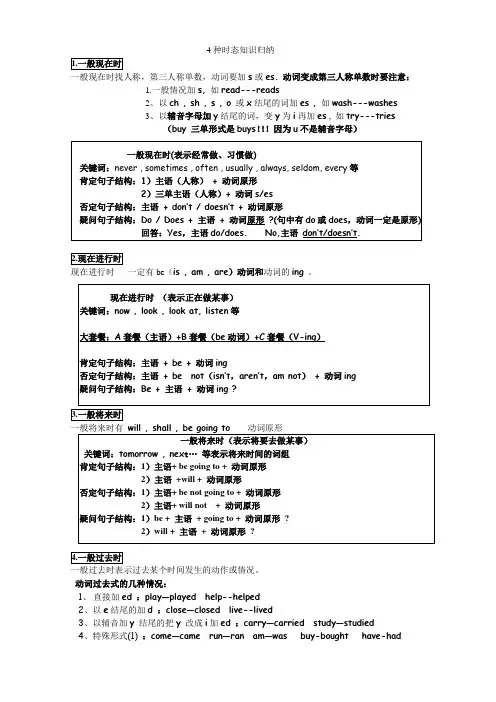
4种时态知识归纳
一般现在时找人称,第三人称单数,动词要加s或es.动词变成第三人称单数时要注意:
1.一般情况加s, 如read---reads
2、以ch , sh , s , o 或x结尾的词加es , 如wash---washes
3、以辅音字母加y结尾的词,变y为i再加es , 如try---tries
(buy 三单形式是buys!!!因为u不是辅音字母)
现在进行时一定有be(is , am , are)动词和动词的ing。
一般过去时表示过去某个时间发生的动作或情况。
动词过去式的几种情况:
1、直接加ed :play—played help--helped
2、以e结尾的加d :close—closed live--lived
3、以辅音加y结尾的把y 改成i加ed :carry—carried study—studied
4、特殊形式(1) :come—came run—ran am—was buy-bought have-had
fall-fell fell -felt (这两个要区分)。
广州小学英语三年级到六年级知识点总结
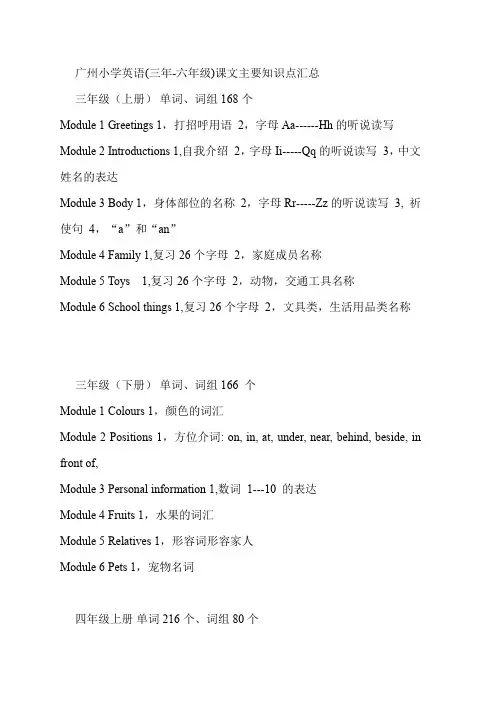
广州小学英语(三年-六年级)课文主要知识点汇总三年级(上册)单词、词组 168个Module 1 Greetings1,打招呼用语2,字母Aa------Hh的听说读写Module 2 Introductions 1,自我介绍2,字母Ii-----Qq的听说读写3,中文姓名的表达Module 3 Body 1,身体部位的名称2,字母Rr-----Zz的听说读写3, 祈使句4,“a”和“an”Module 4 Family 1,复习26个字母2,家庭成员名称Module 5 Toys 1,复习26个字母2,动物,交通工具名称Module 6 School things1,复习26个字母2,文具类,生活用品类名称三年级(下册)单词、词组166 个Module 1 Colours 1,颜色的词汇Module 2 Positions 1,方位介词: on, in, at, under, near, behind, beside, in front of,Module 3 Personal information 1,数词1---10 的表达Module 4 Fruits 1,水果的词汇Module 5 Relatives 1,形容词形容家人Module 6 Pets 1,宠物名词四年级上册单词 216个、词组 80个Module 1 My bedroom 1, 卧室和家具的词汇;2,方位介词:in, on, between, near, next, behind, beside, opposite,,,Module 2 My House 1, 房间的词汇:2,“有”的表达:have/ has; there beModule 3 My school 1,与学校有关的词汇;2,部分数词,1----10; 20---30 Module 4 My class 1, 学科词汇;2,用数量词表示物体Module 5 Clothes : 1, 询问价格 2, 衣物类单词3, 数词的记忆Module 6 Occupations : 1, 职业的词汇;2,句型:What do you want to be want you grow up? 2. What does he do?四年级下册单词179个词组130个Module 1 People : 1,如何描述人的外貌和性格Module 2 Daily routine 2,与日常生活为主题的词汇2,时间的表达Module 3 Days of the week 1,星期的表达Module 4 Activities 1,日常活动的词汇2,现在进行时Module 5 Sports1,体育运动有关的词汇Module 6 Celebrations 1,月份与节日的表达五年级上册单词199个词组200个Module 1 Hobbies 1,爱好主题相关的词汇;2,动词现在分词Module 2 Abilities ; 1. 活动名称,运动场所,职业的词汇;2,情态动词“Can”的用法Module 3 Daily life 1,日常生活的词汇,2,第三人称单数的使用方法Module 4 Foods and drinks 1,饮料与食品有关的词汇,2,食物数量的表达Module 5 Foods we need 1,表达食物的味道,2,食物数量的表达Module 6 Weather 1,天气相关的词汇,2, 数字,月份季节等五年级(下册)Module 1 Seasons 1,季节的词汇Module 2 Plans 1,与计划有关的活动名称及序数词2,日期的表达3,一般将来时Module 3 Invitations1,与邀请相关的词汇Module 4 Travel1,与旅游相关的词汇2,交通工具的表达Module 5 Safety1,与安全相关的词汇2,祈使句用法3,情态动词Module 6 Directions 1,与问路相关的词汇2,祈使句用法六年级(上册)单词107个词组 118个Module 1 Country Life : 农村生活词汇;Module 2 City Life ; 动物类,植物类,城市生活词汇Module 3 Health: 一般过去时,健康方面词汇Module 4 Past Experiences : 一般过去时,描述过去经历Module 5 Changes: 一般过去时,描述过去经历Module 6 Festivals : 1.中西方传统节日的名称,相关的活动;2,时间介词in, on at六年级下册单词 140个词组 130个Module 1 Stories 1,与故事有关的词汇2,动名词做主语Module 2 Animals1,与动物有关的词汇Module 3 Famous people1,与历史人物有关的词汇2,感叹句Module 4 Good manners1,与文明礼仪有关的词汇2,Module 5 Travel abroad1,与旅游有关的词汇Module 6 Let's look back。
广州版小学英语每单元要点
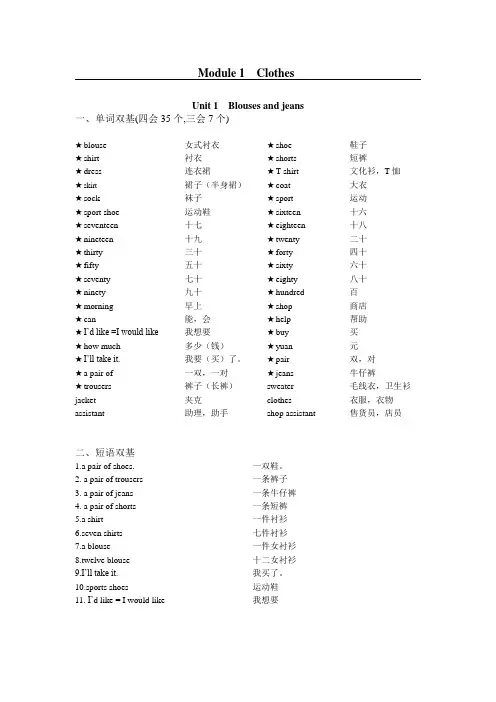
Module 1 ClothesUnit 1 Blouses and jeans 一、单词双基(四会35个,三会7个)11. I’d like = I would like 我想要四、知识点Dialogue:A)Shop assistant: Good morning, Can I help you?Woman: Y es, please, I’d like to buy that blouse. How much is it ?Shop assistant: It’s ninety yuan.Women: OK, I’ll take it .B)Count from 1 to 100, then do the sums in groups.What’s ten and twenty?T en and twenty is thirty.Sixty and fifteen is ________? Thirty and eighteen is ____________?C)Play the game.He is wearing a blue T-shirt, a pair of white socks and a pair of grey sport shoes.Who is he?Unit 2 Shirts,Dresses and Trousers一、单词双基(四会4个,三会3个)二、短语双基四、知识点Dialouge:A) Shop assistant: Good morning, sir. Can I help you?/ What can I do for you?Man : I’d like to buy that blue shirt. / I’d like to buy a black dress. Do you have any ?Shop assistant: Yes, sir. Here you are.Man: How much is it ?Shop assistant: Forty-five yuan.Man: All right, I’ll take it. / OK, / That’s all right. I’ll take it .Shop assistant: Here you are , Thank you.B) Whose T-shirt is it?It’s Xiaoling’s.D)Mother: Look! There’s a strange animal.Ann: No, it’s not. It’s a little man.Fanther: But it’s got two noses and three eyes.Ann: It must be from space ,Look, there’s a spaceship.Alien: Hello. My name’s Billy.Father: Hello, Billy.Mother: Why are you wearing your clothes like that?Alien: what do you mean?Father: Y ou’re wearing gloves on your ears.Alien: Is that wrong?Son: Yes, we wear gloves on our hands. And you’re wearing shoes on your hands. Why?Alien: Is that wrong?Son: Yes, we wear gloves on our hands. And you’re wearing shoes on your hands. Why?Alien: My hands are cold.Ann: But we wear shoes on our feet.Alien: I want to wear clothes as you do .Mother: OK, We’ll help you.MODULE 2 PEOPLEWhat do these people look like?UNIT4 Friends二、短语双基四、知识点DialougeA)Tomoko: Who’s that ?Mr Chen: Which one?Tomoko: The boy over there.Mr Chen: Y ou mean that short boy with a black cap?Tomoko: No, he’s not short and he’s not wearing a black cap. He’s wearing a yellow T-shirt and a brown hat. And he’s wearing a pair of black-and –white sport shoes.Mr Chen: Oh, that’s an American boy . His name’s Mike. He’s my friend.B)FingerThumb \ pointer finger \ middle finger \ ring finger \ little fingerC)Hans comes from Germany. He is tall and has long arms and legs. He has a square face, bigeyes, a small nose and a big mouth. He’s wearing an orange shirt and a pair of brown trousers.He’s wearing a brown cap and a pair of black sunglasses. His shoes are black._______________________________________________________________________________UNIT 5 Our Heroes And Heroines一、单词双基(四会12个,三会13个)四、知识点Story Time:Rabbit: Y ou’re small, ugly and slow! Ha-ha-ha!Tortoise: Well, Mr Rabbit. Let’s have a race.Let’s see who gets first to the house over there, you or me.Rabbit and Tortoise: Ready , go!Rabbit: Y ou are so slow!Rabbit: Well, I am fast and I am winning! I can take a break.Tortoise: I’m slow. I can’t stop!Tortoise: I am the winner!Rabbit: Oh, no! I am the slow one.Module 3 OccupationsWhat do you want to be when you grow up?Unit7 Our Future Jobs一、单词双基(四会15个,三会8个)4. Do you want to be a bank manager when you grow up?Unit 8 My Parents’ job 一、单词双基(三会7个)二、短语双基Module 4 People Who Help UsWho can help us?Unit 10 My New Neighbour 一、单词双基(四会16个,三会12个)I can catch criminals. 我能抓贼。
六年级广东版英语知识点
六年级广东版英语知识点一、词汇知识点1. 动词时态六年级学生需要掌握现在进行时、一般过去时、一般将来时等基本动词时态的运用。
例如:- The students are playing soccer in the playground now.(现在进行时)- Yesterday, I went to the zoo with my family.(一般过去时)- We will have a party next week.(一般将来时)2. 名词复数形式六年级学生需要熟记常见名词的复数形式,并能正确运用。
例如:- There are three cats in the garden.(cat的复数形式为cats)- I have two books on my desk.(book的复数形式为books)3. 形容词比较级和最高级学生需要学会形容词比较级(比较两者)和最高级(比较三者或三者以上)的构成和运用。
例如:- Tom is taller than Jack.(比较级)- Jane is the most intelligent in our class.(最高级)二、语法知识点1. 现在进行时学生需要了解现在进行时的构成和用法,即be动词+动词-ing。
例如:- They are swimming in the pool.(他们正在游泳)2. 一般过去时学生需要学会一般过去时的构成和用法,即动词过去式的变化规则。
例如:- We visited the museum last weekend.(上个周末我们参观了博物馆)3. 表示将来的时间状语学生需要掌握用于表示将来的时间状语,如tomorrow(明天)、next week(下周)等。
例如:- I will meet my friends tomorrow.(我明天将会见我的朋友)三、阅读理解知识点1. 理解短文内容学生需要通过阅读短文,理解其中的主要内容,并能回答相关的问题。
广州版小学英语知识点总结
1.小学英语知识点总结一、字母及音标知识重点是单元音和双元音的区分;难点是清辅音和浊辅音的区分..二、词汇掌握一定量的词汇;对词汇训练题及阅读理解、写作都是非常重要的..小升初对词汇的考察几乎贯穿到了所有题目..三、词法词法部分主要在词法运用上来体现;多以选择题、用所给单词的恰当形式填空的形式出现..一名词的数和格1.名词的数:名词分为可数名词和不可数名词..可数名词变复数不可数名词量的表示:a+表示这些东西的单位+不可数名词;如 a cup of tea..如果为了表示“多个”的概念;我们就将表示这些东西的单位变成复数即可..如3 cups of tea..姓氏的复数形式前面加表示“······一家”..如;the Whites.2.名词所有格表示人或物品所属关系时;我们就需要使用名词所有格..它的构成有以下规则:二动词表示动作和状态的词叫做动词..通常词的学习与时态结合起来学习;它分为:一般现在时“三单”人称V. + s/es; 一般过去时V. + ed; 现在进行时V. + ing ..三形容词、副词形容词和副词的比较级和最高级的构成规则:通常词尾+er / est..比较级和最高级不规则变化的形容词和副词:many/much-more-most; good/well-better-best; bad/badly-worse-worst; little-less-least 形容词和副词的比较级和最高级的用法:比较级用于二者的比较;表示“更······”之意..而最高级用于三者或三者以上的比较..表示“最······”..两者比较时句中有than..形容词最高级前一定要有the;而副词最高级前则不需要..四代词:人称代词和物主代词1.人称代词的宾格2.名词性物主代词3.不定代词some、any、one、ones:some表示“一些”;可以接可数复数名词..any 用在疑问句或否定句中..One代表单数可数名词;ones代表复数可数名词..五数词数词包括基数词和序数词..它们的用法:时间的表达、年、月、日的表达、数学符号的表达..六冠词冠词分为定冠词、零冠词和不定冠词..1.不定冠词:a用在以辅音音素开头的单数可数名词..an用在以元音音素开头的单数可数名词前..2.定冠词the的用法:特指某一个具体的人或事物;指说话的两个人都心照不宣的同一个人或事物;指上下文中提到的人或物;用在序数词、形容词最高级以及方位词的前面..用在世界上独一无二的事物前;用在乐器名词前;用在固定搭配中..3.零冠词:国名、地名、人名等专有名词前;名词前已经有this、that、his、my、any等限定词时;其它情况..七介词1.介词in的用法:1 in 后面加上“衣帽”类单词;表示“穿戴着……”..如:In a coat 穿着外套 in dress穿着裙子In T-shirts穿着短袖 In shorts穿着短裤in shoes穿着鞋子 In socks穿着袜子2in 后面加“位置”类单词;表示“在……里面”..如:The books are in my desk. 这些书在我的书桌里..2. at: 在1 表示时间;后接具体时间点;2 表示地点;后接小地点Let’s meet at 7:00 in the evening.I am at home now.3. With: 有;和……在一起with a cap 、 with a hatWith a bag in her hands. 她手里拿着一个包..4. Beside: 在……旁边There is a river beside my house.四、句法与句型小学部分涉及到四种时态:一般现在时、一般将来时、一般过去时、现在进行时..在考试的作文部分;经常会考到:描写人、动物、城市、植物、节日、季节、过去事情、一天的日程安排、计划及看病、问路、打电话等话题的作文..在写的时候首先一定要选准时态;每时每刻都要注意有没有用错;写完一定要复查..一一般现在时1.一般现在进行时的定义及标识词:表示经常、习惯性动作..关键是掌握①标志词:always; usually; often; never; sometimes; seldom; every+时间等..②当主语是第三人称单数时;动词就要加s/es.其它人称统一用动词原形..二一般将来时1.一般将来时表示将要发生的事情..通常用两种形式来表示:1be going to+动词原形;2will/shall+动词原形..前者强调“打算”要做一件事情;而后者只是客观地说明一件事情将要发生..三一般过去时1.一般过去时表示在过去某一时间里发生的事情..我们用动词的过去式来表示;也就是说在动词末尾+ed来完成..四现在进行时1.现在进行时表示正在进行的动作..其谓语的特点是:be + V-ing..学好现在进行时的关键是①be动词的选择②动词—ing的变化规则..刚开始学习英语的同学;往往对我联系动词be与主语人称保持一致的问题把握不好..为此;建议在歌谣中熟悉我联系动词的“身影”:我用am;你用are;is用在他、她、它;遇到复数全用are..五There be句型There be句型用来表示某地 /某时有某物/某人..五、英语常识英语常识渗透在一些主观题上;平时一定要多留心..1.常见的节日2.国家、首都、语言、国籍、最大的城市3.中国和西方不同之处六、课后练习一、语音:找出划线部分读音不同的单词B. bookC. lookD. cook1. A. toothB. spreadC. meanD. peace2. A.cheapB. roundC. houseD. young3. A.loudB. noiseC. hasD. maps4. A.flags5. A.B. bankC. certainD. drinkuncle二、单项选择6. I have ________ to tell you. But first; please help _________ to _________fish; children.A. anything important; our; anyB. something important; yourselves; someC. important everything; yours; eachD. important thing; us; other7. Tom and Jerry are twins and they are_________. Their family ________ good. Now the family_________ watching TV.A. we heros; are; areB. ours heros; are; isC. our heroes; is; areD. us heroes; is; is8. ---Have you seen _____bag I left it here just now. It’s _____ Browns.--- Is it ________ one on the chair near the doorA. a; the; theB. the; the; theC. a; a; aD. the; the; a9. Do it__________. The film will be on_________ 30 minutes. I think the Captain America. The first Avenger is __________ X Men.A. quickest; by; more 2 hundreds times interesting thanB. quicker; for; 2 hundred time less interesting thanC. more quickly; in; 2 hundred times less interesting thanD. quicklier; to; 2 hundreds time more interesting than10. When we are________; he is alone _________ with nothing.A. at table; at the tableB. at a table; on tableC. on the table; on tableD. on table; at a table11. The weather is not too cold______ too hot in this season. Let’s go ______ a science trip.A. and; forB. nor; toC. but; withD. or; on12. She is ________ surprised________ she can’t believe her eyes. I’ll tell her the truth________ I see her.A. too; to; andB. so; that; as soon asC. such; so; whenD. not; but; that13.There_________ any bread in the fridge. Let’s _________ to buy some;________A. are; goes; will youB. is; going; will youC. aren’t; went; shall weD. isn’t; go; shall we14. I_______ nothing in my pocket. But ________ iPhone and 2 computers on the table.A. have; there is anB. has; I haveC. there be; there areD. there be; there is a15. Her handwriting is as________ as________.A. well; IB. better; meC. good; mineD. best; mind16. _________ clever you areA. What aB. HowC. WhatD. How a17. I want to find a good book. I’m going to the_________.A. cinemaB. libraryC. museumD. supermarket18. Who’s the lady _______ blueA. inB. onC. atD. with19. Those must________ tulips.A. beingB. isC. areD. be20. ---_________do you go to the cinema ---Seldom.A. WhenB. What timeC. How oftenD. Which三、根据中文; 完成下列的句子; 每空格填一词..21. 孙中山反对帝制;他尽力改变中国和解放人类..Dr .Sun Yatsen was__________ the emperor. He_________ to change China and _______ the people.22. 莫扎特是最伟大的音乐家之一..Mozart was ______________ of the __________ _______________.23. 每天狮子在深林里四处闲逛找食物; 一旦抓到公牛;它就马上把牛吃光..Every day; the lion went around in the forest___________ for food. Once it catches one bull; it will eat it ____________ at ___________.。
广州小学英语三年级到六年级知识点总结
广州小学英语三年级到六年级知识点总结广州小学英语(三年-六年级)课文主要知识点汇总三年级(上册)单词、词组168个Module 1 Greetings 1,打招呼用语 2,字母Aa------Hh的听说读写Module 2 Introductions 1,自我介绍2,字母Ii-----Qq的听说读写 3,中文姓名的表达Module 3 Body 1,身体部位的名称 2,字母Rr-----Zz的听说读写 3, 祈使句 4,“a”和“an”Module 4 Family 1,复习26个字母 2,家庭成员名称Module 5 Toys 1,复习26个字母 2,动物,交通工具名称Module 6 School things 1,复习26个字母 2,文具类,生活用品类名称三年级(下册)单词、词组166 个Module 1 Colours 1,颜色的词汇Module 2 Positions 1,方位介词: on, in, at, under, near, behind, beside, in front of,Module 3 Personal information 1,数词 1---10 的表达Module 4 Fruits 1,水果的词汇Module 5 Relatives 1,形容词形容家人Module 6 Pets 1,宠物名词四年级上册单词216个、词组80个Module 1 My bedroom 1, 卧室和家具的词汇; 2,方位介词:in, on, between, near, next, behind, beside, opposite,,, Module 2 My House 1, 房间的词汇: 2,“有”的表达:have/ has; there beModule 3 My school 1,与学校有关的词汇;2,部分数词,1----10; 20---30Module 4 My class 1, 学科词汇; 2,用数量词表示物体Module 5 Clothes : 1, 询问价格2, 衣物类单词3, 数词的记忆Module 6 Occupations : 1, 职业的词汇;2,句型:What do you want to be want you grow up? 2. What does he do?四年级下册单词179个词组130个Module 1 People : 1,如何描述人的外貌和性格Module 2 Daily routine 2,与日常生活为主题的词汇 2,时间的表达Module 3 Days of the week 1,星期的表达Module 4 Activities 1,日常活动的词汇 2,现在进行时Module 5 Sports 1,体育运动有关的词汇Module 6 Celebrations 1,月份与节日的表达五年级上册单词199个词组200个Module 1 Hobbies 1,爱好主题相关的词汇; 2,动词现在分词Module 2 Abilities ; 1. 活动名称,运动场所,职业的词汇; 2,情态动词“Can”的用法Module 3 Daily life 1,日常生活的词汇,2,第三人称单数的使用方法Module 4 Foods and drinks 1,饮料与食品有关的词汇, 2,食物数量的表达Module 5 Foods we need 1,表达食物的味道,2,食物数量的表达Module 6 Weather 1,天气相关的词汇, 2, 数字,月份季节等五年级(下册)Module 1 Seasons 1,季节的词汇Module 2 Plans 1,与计划有关的活动名称及序数词 2,日期的表达 3,一般将来时Module 3 Invitations 1,与邀请相关的词汇Module 4 Travel 1,与旅游相关的词汇 2,交通工具的表达Module 5 Safety 1,与安全相关的词汇 2,祈使句用法 3,情态动词Module 6 Directions 1,与问路相关的词汇 2,祈使句用法六年级(上册)单词107个词组118个Module 1 Country Life : 农村生活词汇;Module 2 City Life ; 动物类,植物类,城市生活词汇Module 3 Health : 一般过去时,健康方面词汇Module 4 Past Experiences : 一般过去时,描述过去经历Module 5 Changes : 一般过去时,描述过去经历Module 6 Festivals : 1.中西方传统节日的名称,相关的活动; 2,时间介词 in, on at六年级下册单词140个词组130个Module 1 Stories 1,与故事有关的词汇 2,动名词做主语Module 2 Animals 1,与动物有关的词汇Module 3 Famous people 1,与历史人物有关的词汇 2,感叹句Module 4 Good manners 1,与文明礼仪有关的词汇 2,Module 5 Travel abroad 1,与旅游有关的词汇Module 6 Let's look back。
广州小学英语三至六年级课文主要知识点汇总
三年级(上册)Module 1: Greetings 26个字母;打招呼用语Module 2:My BodyModule 3: StationeryModule 4: ColoursModule 5: TransportModule 6: Numbers and shapes四年级 (上册)Module 1:Clothes1.询问价格2.衣物类单词、数词的记忆Module 2: PeopleModule 3: Occupations(职业)1.What do you want to be want you grow up?2.What does he do?Module 4: People who help us情态动词的用法Module 5:Time for/toModule 6: Days of the week1.星期/疑问词 at+时间, on+星期, in+月份/季节四年级(下册)Module 1:Age How old…? Module 2:Activities1.现在进行时Module 3:SportsModule 4:Entertainment1、like doing2、一般现在时态Module 5:Food and drinks1.Would you like some……?2.一般现在时态Module 6:shopping五年级(上册)Module 1: Routines and dates1.一般现在时态2.序数词、月份和季节Module 2: Abilities1.情态动词“Can”的用法Module 3: Plants1.植物的名称2.Can 的理解和运用3.一般将来时和现在进行时Module 4:Travel1.be going to2.用“a quarter, half, past, to”来表达时间Module 5:Zoo animals1.Do you like……?2.Would you like to do…?3.Don’t….4.现在进行时态Module 6:Directions1.Can you tell me the way to…,please?2.Turn right/left. Go straight ahead五年级(下册)Module 1: Our life1.一般现在时态 am/pm2.情态动词“may,should”;比较级Module 2: Seeing a doctor1.It’s time to….2.It’s time for….3.be late for.Module 3:Our school and Our class1.形容词的比较级Module 4:Wild Animals1.形容词的最高级Module 5:Eating Habits1.事物名称2.prefer./like…bestModule 6: Weather1.比较级2.季节六年级(上册)Module 1: Plans1.一般将来时:be going to2.What are you going to? I'm going to……. Module 2: Cities1.国家名称、首都。
- 1、下载文档前请自行甄别文档内容的完整性,平台不提供额外的编辑、内容补充、找答案等附加服务。
- 2、"仅部分预览"的文档,不可在线预览部分如存在完整性等问题,可反馈申请退款(可完整预览的文档不适用该条件!)。
- 3、如文档侵犯您的权益,请联系客服反馈,我们会尽快为您处理(人工客服工作时间:9:00-18:30)。
1.小学英语知识点总结
一、字母及音标
知识重点是单元音和双元音的区分,难点是清辅音和浊辅音的区分。
二、词汇
掌握一定量的词汇,对词汇训练题及阅读理解、写作都是非常重要的。
小升初对词汇的考察几乎贯穿到了所有题目。
三、词法
词法部分主要在词法运用上来体现,多以选择题、用所给单词的恰当形式填空的形式出现。
(一)名词的数和格
1.名词的数:名词分为可数名词和不可数名词。
可数名词变复数
不可数名词量的表示:a+表示这些东西的单位+不可数名词,如 a cup of tea。
小学英语。
